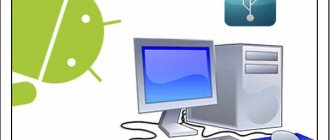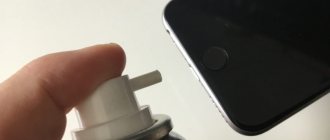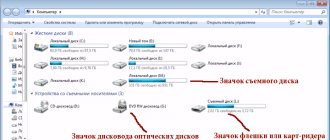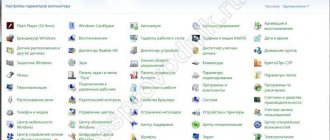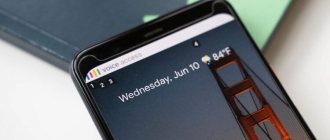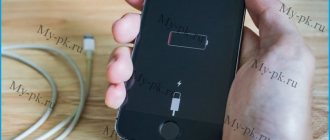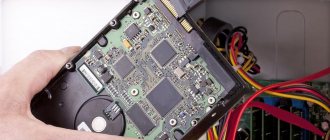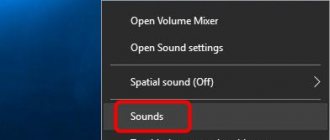If, when connected via USB, the computer does not see Android as a flash drive or media player, then the reason should be looked for in the settings of the device and PC. Usually the cause of the problem is software in nature and can be quickly resolved, but in some cases it may be necessary to replace the cable or connector.
This article is suitable for all brands that produce phones on Android 11/10/9/8: Samsung, HTC, Lenovo, LG, Sony, ZTE, Huawei, Meizu, Fly, Alcatel, Xiaomi, Nokia and others. We are not responsible for your actions.
Attention! You can ask your question to a specialist at the end of the article.
Causes
Software and hardware failures lead to a situation where the PC does not recognize the mobile device connected to it:
- Lack of device driver in the PC operating system.
- The driver does not match the device model.
- There is no USB driver in the system or it is malfunctioning.
- Connection with a cable that is not suitable for data transmission or is damaged.
- Malfunction of the USB socket (both on the computer and on the phone), group of sockets or USB controller on the PC.
- Failure of any of the computer equipment, blocking by static electricity.
- Error in phone system settings.
- Blocking access to the phone using security programs running on a PC (including if the gadget is infected with a virus).
- The application used to synchronize your phone and PC (if you are using) has crashed.
In case of software problems, the computer, as a rule, does not display the contents of the phone’s memory, but the device charges normally when connected to it. If the problem is due to a physical malfunction, charging most often does not work either, but there are exceptions when only the data lines do not work.
An analysis of the previous situation—what happened before the problem arose—helps outline the range of possible causes. For example:
- You have reinstalled the operating system on your computer or removed some of the drivers (the reason is that the required driver is missing).
- The phone (tablet) was no longer detected after flashing the firmware, cleaning it from viruses, deleting applications, optimizing and other manipulations with the OS (the operating system of the mobile device malfunctioned).
- The device has been subjected to mechanical damage (the USB socket is damaged) or has been repaired (after replacing parts, a driver of a different version is needed or the fault has not been completely eliminated).
- You are using a USB cable that you have never used to connect your phone to a computer before (the cable is only for charging or is damaged), etc.
We quickly determine the culprit of the problem
Tracing a cause-and-effect relationship makes it much easier to localize the problem, but in about half of the cases there is nothing specific that precedes it. If this is the case for you, the following steps will help you determine where the failure occurred - in your mobile device, PC or USB cable.
- Move the cable in the area of the connectors (kinks most often form in these places) and see if the phone (tablet) is detected in the explorer or device manager of the computer. Or connect the devices with another cable that is known to work and is suitable for data transmission.
- Connect your phone to another computer, as well as another mobile device to this PC. If the phone is not detected anywhere, the problem is definitely in it. The same is the case with a computer.
- If the problem seems to be in the computer, check the phone in all USB sockets; perhaps the problem is in one or more of them (for example, only in the front group).
If you conclude that the cable is the source of the problem, simply replace it. What to do in other cases, read on.
You connect your phone to a computer or laptop via a cord, but the computer does not see the phone
Many users, when trying to connect their phone to a computer using a USB cable, are faced with the fact that the computer does not recognize the connected gadget. The connected device is charging. At the same time, there is no access to the smartphone itself and its internal content.
I also encountered this synchronization problem, and in this material I will tell you why the computer does not see the phone via USB, and I will also share various methods for solving this issue.
The culprit of the failure is the phone. What to do?
If the diagnostics clearly indicate a problem with your mobile device, perform the following steps in order. After each step, check to see if the problem is resolved. If not, move on to the next one.
- Reboot your device.
- Connect your phone to your computer. Once connected, slide down the Quick Settings menu bar and make sure that the “Connect as” list doesn’t include “o” or “camera” or “media device.” Select the "USB storage" option.
- Open Android system settings (in older versions, “Options”). Go to the "Wireless Networks" section. Turn on modem mode. Or vice versa, if it is on, turn it off. In some editions of Android, this parameter controls not only the modem, but also the connection of the gadget to the PC as a drive.
- Experiment with putting your device into USB debugging mode. Open the “System” and “For Developers” sections in the settings. Uncheck or check the box next to “USB Debugging”.
- Disconnect the phone from the computer, turn it off and remove the battery from it (the phone) (of course, if it is removable). After 5 minutes, replace the battery, turn on the device and try connecting again.
- Remove applications that failed after installation. If the connection doesn't work in a particular sync app, clear its cache. If it doesn’t help, reinstall (both on your mobile device and on your PC) or try using an analogue.
- Scan your device with an antivirus.
- Reset the device's operating system to factory settings.
How to connect Samsung to computer via USB cable?
Why might you need to connect your smartphone to your PC?
- You need to back up your Galaxy data.
- You need to transfer files between devices.
- You want to use your phone as a flash drive.
- Update the firmware manually.
Important! In order for your laptop to see your device, you may need drivers for your smartphone. You can download them to your PC from the official Samsung website, first specifying the phone model.
How to connect Galaxy to a computer?
- Take the cord and connect the device to the USB port.
- An icon should appear in the panel on the device. Expand it, tap on the corresponding notification.
- Click on the item to connect as a USB drive.
- Confirm the action.
You can perform the same operation through the phone menu:
- Open settings.
- Select the “Wireless Networks” section.
- Find "USB Tools".
- Click on "Connect the drive to PC".
- Then click on “Connect USB storage” and confirm.
Sources
- https://o-phone.ru/samsung-galaxy-ne-vidit-pk.html
- https://moydrugpc.ru/podklyucheniya-k-kompyuteru
- https://soft.mydiv.net/win/download-Samsung-Kies.html
- https://KtonaSoft.ru/samsung-kies/
- https://ru.wikipedia.org/wiki/Samsung_Kies
- https://getprogram.net/index.php?d=68
- https://samsung-wiki.com/kak-podklyuchit-samsung-k-kompyuteru.html
[collapse]
The culprit of the failure is the computer. What to do?
- Shut down the OS, turn off the PC from the outlet (or press the key on the power supply) and hold down the power button for 15-20 seconds. This will discharge the capacitors and remove stray static charge, which may block detection of the connected device.
- If the phone is not recognized by only one group of USB ports, open the cover of the system unit and make sure that they are connected securely. By the way, normal charging of a mobile device through the port does not mean that the second one is working properly.
- Boot the operating system. Open Device Manager and check if portable devices are listed in the equipment list, and your phone is among them. If it is present, but marked with a black arrow in a circle (disabled), right-click on the line and select the “Enable device” command from the menu.
- If there are unknown devices in the hardware list (indicated by an exclamation point in a yellow triangle), one of them may be the phone. To make sure it is him, disconnect your mobile device from USB. If the unknown device disappears from the list, then that’s it. And the reason for the failure is the lack of the required driver in the system. We will tell you below how to reinstall and where to download the driver for your phone.
- The problem with recognizing connected devices may also be due to boot failure, damaged or missing USB drivers. In this case, the exclamation marks will be in the “USB Controllers” section.
- Reinstalling drivers didn't help? Scan your computer disks with an antivirus and then temporarily disable security programs. By the way, the latter can block access to a mobile device as a storage medium if it contains suspicious or clearly malicious software. So it’s worth checking your phone for viruses too.
- Uninstall the programs whose installation caused the problem, or perform a system restore to a checkpoint created on a day before the problem occurred.
- If, in addition to the phone, the computer does not recognize other devices connected via USB - a mouse, keyboard, printer, flash drives, etc. (whether they are charged or not is not indicative), the source of the failure may be any faulty component of the system unit or something then from the periphery. You can determine the culprit at home by turning off the equipment one by one or replacing it with a known good one.
USB connection settings
The next most common and important factor is the Android device settings. If the phone is connected to a PC to transfer data, and this section is set to “Charging only,” then nothing will happen to the computer when connected, and the smartphone will simply charge.
Usually, when pairing, a USB icon appears in the status bar of the smartphone (top line with notifications and time). You need to click on the notification and in the settings that open, select the desired item, in our case “USB drive”.
If there is no notification in the status bar, you need to go to the settings, use the search for the phrase “USB” and find there the same settings as described above.
How to Reinstall Mobile Device Driver and USB on Windows Computer
iPhone
- Connect iPhone to PC.
- Open the folder %CommonProgramW6432%\Apple\Mobile Device Support\Drivers (to avoid typing the command manually, copy it from here, paste it into the address bar of any folder and click the go button). It contains 2 files (out of four) with the .inf extension - usbaapl.inf and usbaapl64.inf.
- Open the context menu of each of these files and run the “Install” command.
- After installation, restart your computer.
Android
Smartphones and tablets for Android, such as Samsung, Xiaomi, Lenovo, Meizu, HTC, etc., as a rule, do not create separate folders for storing their drivers, and they are often not found on official websites so you can just download and reinstall. Therefore, to begin with, you should trust the reinstallation of the drivers already present in the system by Windows itself.
How to do it:
- Open the context menu of the problematic device in Device Manager. Select the "Update Driver" option.
- In the next window, first select automatic search for updates. If Windows does not find anything suitable, check the second item - installing and searching for drivers manually.
- Next, click “Select from the list available on your computer.” A new window will display all mobile device drivers that are already installed on the PC.
- To narrow your search, in the “Select a driver for this device” section, check “Compatible only.” Check the one that best suits your request (if there is more than one item in the list) and click “Next” to proceed to the installation.
For the driver to work correctly, restart your computer.
If reinstalling the driver already installed in the system did not help, you will have to look for something else on the Internet (with the risk of downloading a virus instead of the one you are looking for), so download them only from reliable and trusted sites, like w3bsit3-dns.com, and check with an antivirus before installation.
Drivers for the most common models of mobile gadgets are also collected in the “USB Drivers for Android” application, which is available for free download on Google Play.
USB drivers for Windows can usually be easily found on the websites of laptop or desktop PC motherboard manufacturers. Sometimes they are included in the chipset driver.
How to fix USB OTG problems on Android devices
How to fix USB OTG problems on Android devices
L Learn how to fix USB OTG related problems on Android devices which can occur due to a number of reasons and you should know all of them to fix them easily. So follow the complete instructions below.
Smartphone technology is evolving at a rapid pace and has now gained incredible power to work, connect and analyze with other accessories. The most important role in increasing the intelligence of smartphones is the expansion of USB capabilities. With USB OTG functionality in a smartphone, the entire spectrum of flexibility has come into play.
In case you don't know, USB On-The-Go (OTG) is a standardized specification that allows a device to read and write data from a USB device. Thus, USB OTG becomes a USB host and allows other devices such as flash drive, digital cameras, keyboard, mouse, etc. to connect to Android. However, not every Android device supports USB OTG and even if it does, users face a lot of issues with it.
So, to help users facing problems with USB OTG on their smartphones, we have written this article where we have discussed and relatively written about solutions to various problems regarding USB OTG. Just read the article to know about these questions and their solutions!
If the phone is not recognized in firmware mode
The fact that the computer and phone do not see each other in fastboot mode is indicated by the message “Waiting for device” that appears in the firmware program. Most often, this error occurs due to the lack of a mobile device driver in the system, so first of all, do what is written above - reinstall the driver or download and install it again.
If it doesn't help:
- Make sure that you follow the instructions for working with the firmware installation program exactly and that it is running as an administrator.
- Check if USB debugging is enabled on your smartphone (if not, enable it), and the device itself is in bootloader mode. If this mode is blocked, find instructions online for unlocking the bootloader specifically for your device model.
- Connect the phone to the rear USB socket as short as possible and with a known good cable, without using any adapters or hubs.
- Your phone may not support USB 3 (blue socket), so only connect it to USB 2.0 (black sockets).
- Install all released Windows updates on your computer.
If the problem persists even after doing this, try flashing the phone on another PC. And better - with a different version of the operating system.
Restart your phone and computer
This may seem too trivial to you, but in some cases this technique helps out. If operating systems work for a long time without rebooting, then errors can accumulate in them.
Start with this technique, it is the simplest and most accessible to everyone. I think all readers know how to restart a computer. Recommendations for rebooting (turning off and on) the tablet should be given in the instructions for its use. You can also refer to the manufacturer’s website or thematic forum for information.
You can also try to close non-critical processes in Windows using Task Manager. After that, connect the tablet to USB again.
When the problem is a broken physical interface
It is advisable not to use faulty physical interfaces, especially on a mobile gadget, at all (do not load them with current to avoid worsening the breakdown), even if the phone or tablet retains the ability to charge through them. You can organize content transfer either wirelessly (Wi-Fi, bluetooth) or through cloud services that are available on both devices. In particular, iTunes and iCloud for Apple technology, Google Drive, Yandex Disk, Dropbox, Microsoft OneDrive and many others - for everyone.
Cloud services are convenient to use for transferring photos, videos, music, documents and other types of files. To synchronize contacts on Android and PC, the capabilities of Gmail are sufficient. And to control your phone directly from your computer, you can install an application like MyPhoneExplorer (consists of 2 parts - for the phone and for the PC), which supports both wired and wireless connections of devices without requiring driver installation. Very comfortably.
In short, there is always a way out and it is often much simpler than it seems at first glance.
First steps when the “USB device is not recognized” error appears
First of all, if you are experiencing this Windows error when connecting a flash drive, mouse and keyboard, or something else, I recommend making sure that it is not a problem with the USB device itself (this will at least save you time).
To do this, just try, if possible, connect this device to another computer or laptop and check if it works there. If not, there is every reason to assume that the reason is in the device itself and the methods below probably will not work. All that remains is to check the correct connection (if wires are used), connect not to the front, but to the rear USB port, and if all else fails, you need to diagnose the device itself.
The second method, which should be tried, especially if the same device worked fine before (and also if the first option cannot be implemented because there is no second computer):
- Disconnect the USB device that is not recognized and turn off the computer. Unplug the plug from the outlet, then press and hold the power button on the computer for a few seconds - this will remove any remaining charge from the motherboard and components.
- Turn on your computer and connect the problematic device again after Windows boots up. There is a chance that it will work.
The third point, which can also help faster than all that will be described below: if you have a lot of equipment connected to your computer (especially to the front panel of the PC or via a USB splitter), try disconnecting the part of it that is not needed right now, and the device itself If possible, connect the one causing the error to the back panel of the computer (unless it is a laptop). If it works, you don't need to read any further.
Additionally: if the USB device has an external power supply, connect it (or check the connection), and if possible, check that the power supply is working.
What to do if Samsung Galaxy is not recognized by the computer?
Usually, when you connect a smartphone to a computer, it detects it and installs all the necessary drivers. After a few seconds the device is recognized. However, this does not always happen. There are times when the computer sees the device, but cannot recognize it. As a result, you cannot transfer files either there or back.
If you are currently facing this problem, here is what you need to do:
Step 1: Unplug the cable from your phone, restart your phone and computer
Maybe nothing else will be needed. Glitches happen more often than you think, and most can be fixed with a simple reboot. We are trying to help not only your phone, but also your computer, since we do not know where exactly the failure occurred. So disconnect the cable and restart your computer and phone to refresh your RAM to get rid of possible problems.
After rebooting your devices, connect your phone again and check if it is recognized this time. You may need to reinstall the drivers again, and you may have to wait before you know if the device has been recognized. If not, then maybe the problem is with the drivers.
Step 2: Make sure the correct drivers are installed on your computer
The latest operating systems install common drivers for most devices that use a USB connection. This is what happens when you connect the device to your computer; After some time, the computer finds and installs the necessary drivers, and then you can exchange USB files.
However, smartphone manufacturers, especially well-known ones like Samsung, always try to make sure that their device is easily recognized by a computer. Their devices already have their own drivers or software, which makes the process easier. Of course, they must be downloaded from the manufacturer's website. You can also download KIES or Smart Switch.
Step 3: Reset your phone if the problem persists after installing KIES or Smart Switch
The second step is aimed at solving the problem with the drivers, but if this does not help, you need to back up all files and information and reset the settings to a working state.
Read more: How to reset Samsung to factory settings?
- Turn off your Samsung Galaxy.
- Press and hold the Home, Volume Up, and Power buttons
- When Samsung Galaxy appears on the screen, release "Power" but continue to hold the remaining two.
- When the Android logo appears, release all buttons and wait 30-60 seconds.
- Using the Volume Down button, toggle between options and select 'wipe data/factory reset.'
- Click "Power" to confirm.
- Then select 'Yes - delete all user data' using Volume Down and confirm by pressing Power.
- Wait until the process is completed. Then select 'Reboot system now' and click "Power".
- The phone will take a little longer to reboot than usual.
If after this the problem is not solved, the help of a specialist is required. I hope this instruction will help you in one way or another. If you feel you need further assistance, please contact us.
Device Manager and USB Drivers
In this part we will talk about how to fix the error USB device is not recognized in the device manager in Windows 7, 8 or Windows 10. I note that these are several methods at once and, as I wrote above, they may or may not work specifically for your situation.
So, first of all, go to Device Manager. One quick way to do this is to press the Windows keys (with logo) + R, type devmgmt.msc and press Enter.
Your unidentified device will most likely be located in the following sections of the manager:
- USB controllers
- Other devices (and called "Unknown device")
If this is an unknown device in other devices, then you can connect to the Internet, right-click on it and select “Update drivers” and, perhaps, the operating system itself will install everything that is needed. If not, then the article How to install an unknown device driver will help you.
In the case where an unknown USB device with an exclamation mark appears in the "USB Controllers" list, try the following two things:
- Right-click the device, select Properties, then on the Driver tab, click the Roll Back button if available, and if not, click Uninstall to remove the driver. After that, in the device manager, click “Action” - “Update hardware configuration” and see if your USB device is no longer unrecognized.
- Try going to the properties of all devices named Generic USB Hub, USB Root Hub or USB Root Controller and on the “Power Management” tab, uncheck “Allow the computer to turn off this device to save power.”
Another method, the functionality of which I happened to see in Windows 8.1 (when the system writes error code 43 in the description of the problem: USB device is not recognized): for all the devices listed in the previous paragraph in order, try the following: right-click - “Update drivers”. Then - search for drivers on this computer - select the driver from the list of already installed drivers. In the list you will see a compatible driver (which is already installed). Select it and click “Next” - after reinstalling the driver for the USB controller to which the unidentified device is connected, it can work.
The computer does not see the USB flash drive
Firstly, your personal computer most often does not detect the flash drive because it is faulty. To check this, insert the USB flash drive into another device. If it does not work and is not muted, then feel free to buy another flash card. Secondly, check the connector for dirt. Naturally, if banal dirt gets into the flash drive connector, it will not work correctly. Thirdly, try inserting the flash drive into another slot on the computer (usually there are several of them). Next, try formatting your flash drive to match your computer’s file system. You can see what file system is on your PC by going to the properties of the local disk. Now you just need to specify what file system you need when formatting.
Why is my Android phone not visible via USB?
I think it’s worth starting by answering the question: did the computer always not see your phone or did everything work fine before? The phone stopped connecting after actions with itself, with the computer, or without any actions at all - the answers to these questions will help you quickly figure out what exactly is the matter.
First of all, I’ll note that if you recently purchased a new Android device and it is not seen by a computer running Windows XP (while an old Android phone can easily be connected as a USB flash drive), then you should either update the operating system to one of the currently supported ones, or install MTP (Media Transfer Protocol) for Windows XP.
You can download MTP for XP from the official Microsoft website here: https://www.microsoft.com/en-US/download/details.aspx?id=19153. After installation and restarting the computer, your phone or tablet should be detected.
Now let's move on to the situation where the phone is not visible via USB in Windows 7, 8.1 and Windows 10. I will describe the steps in relation to Android 5, but they are similar for Android 4.4.
Note: For devices that are locked with a pattern or password, you need to unlock the phone or tablet connected to the computer in order to see files and folders on it.
Make sure that the phone itself, when connected via USB, reports that it is connected, and not just for charging. You can see this by the USB icon in the notification area, or by opening the notification area in Android, where it should be written what device the phone is connected to.
Typically this is a storage device, but may be a Camera (PTP) or a USB modem. In the latter case, you will not see your phone in Explorer and you should click on the notification about using a USB modem and turn it off (you can also do this in Settings - Wireless networks - More).
If your phone is connected as a camera, then by clicking on the corresponding notification, you can enable MTP mode for file transfer.
On older versions of Android, there are more USB connection modes, and USB Mass Storage will be optimal for most use cases. You can also switch to this mode by clicking on the USB connection message in the notification area.
Note: If you encounter an error when trying to install the MTP device driver in Windows Device Manager, you may find this article helpful: The service installation section in this INF file is incorrect when connecting your phone.
If the problem of the computer detecting a mobile device is not resolved, reset the settings
If your computer still does not see your phone via USB, resetting your smartphone using Hard Reset . Go to the settings of your phone, select the “Backup” menu item, and in it select “Data reset”.
But I’m warning you right away! You will lose your files and settings located in the internal memory of the phone. And the files on the SD card will remain untouched. Therefore, this point should be used only as a last resort!
The phone does not connect via USB to the computer, but only charges
If no notifications about connecting via USB to the computer appear, then here is a step-by-step description of possible actions:
- Try connecting to a different USB port. It would be better if it was USB 2.0 (the ones that are not blue) on the rear panel. On a laptop, accordingly, just USB 2.0, if available.
- If you have compatible USB cables from other devices in your home, try connecting using them. A problem with the cable may also be the cause of the situation described.
- Are there any problems with the jack on the phone itself? Did it change and did it fall into the water? This could also be the reason and the solution here is replacement (I will outline alternative options at the end of the article).
- Check if your phone connects via USB to another computer. If not, then the problem is in the phone or cable (or you didn’t check your Android settings properly). If yes, the problem is on your computer. Do flash drives connect to it at all? If not, try first going to Control Panel - Troubleshooting - Device Settings (to try to fix the problem automatically). Then, if it doesn’t help, follow the instructions The computer does not see the flash drive (as far as drivers and necessary updates are concerned). At the same time, you should try disabling power saving in the device manager for Generic USB Hub.
If nothing from the list helps solve the problem, then describe the situation, what was done and how your Android device behaves when connected to USB in the comments, I will try to help.
Attention: By default, the latest versions of Android are connected via USB to the computer in charge-only mode. Check the notifications for the availability of selecting the USB operating mode if you encounter this (click on the item Charging via USB, select another option).
Problem connecting a USB card to a tablet computer
Some tablets now have the ability to connect a USB drive. You insert a regular flash drive through a special adapter, the tablet does not react at all. So why doesn’t the tablet see the USB flash drive through the adapter?
The main reason for this error is different standard file systems.
Then you need to format the flash drive in FAT32 (this is the system modern tablets are designed for) via a computer. If this does not help, then you need to get root rights to the device and download the StickMount application from Google Play, through which you can install the USB drive virtually after inserting it into the tablet. If none of the above methods help, then think about repairing your tablet. Share this post:
The computer does not recognize the phone via USB - reasons
All possible problems that users encounter can be divided into software or hardware. In the first option, the problem is in the settings, drivers or computer system, in the second - in the cable, USB port of the smartphone or laptop. Almost all problems can be fixed, but before you try to fix connecting your phone to your computer via USB, try restarting your PC and device. This simple procedure often helps, especially with device models from Lenovo, Samsung, HTC, FLY, LG, Nokia.
The phone does not connect via USB to the computer, but it charges
A very common problem with devices is when the phone is not displayed on the computer via USB, but the battery charge indicator is on. The smartphone responds to the connection, but the system does not want to display it. To identify the cause of the failure, you can do the following:
- Move the power cord to a different port on the laptop. Now most models are already equipped with version 3.0 connectors (blue), but you need to use 2.0. For stationary versions, the connection should be made from the back of the case, and not from the front panel.
- Try using a different cord if the sockets match. This will help identify problems with the cable. If one of the twisted pair wires breaks, the smartphone may continue to charge, but not be detected.
- Inspect the device socket to see if there is any debris or dirt inside that disrupts the connection of the contacts and makes it difficult to find the device.
- Try connecting the device to another PC. If it is detected there, then the problem is definitely in your system: there are no drivers, a virus, or the power supply on the laptop is incorrectly configured. This problem will be described in more detail below.
The computer stopped seeing the phone via USB
It often happens that the device was previously detected, but for some reason it suddenly stopped. A common reason why the computer does not see the phone via USB is that the port drivers have crashed. Due to software glitches, the latter stop functioning correctly and are unable to find any connected devices. In this case, there is no need to reboot the device. You need to do the following:
- Find the “native” drive for the motherboard. The set must contain all system files for the correct operation of the USB ports.
- If the disk is lost, find the developer’s website on the Internet. Manufacturers, as a rule, make all the necessary software freely available.
- Reinstall the drivers.
After the PC has finished installing the files, you need to restart the computer. Only at this moment is it time to check whether the system can recognize the device. If these steps do not help, make additional settings:
- In the Control Panel, go to the "Power" section.
- Select "Set up power plan" (for laptops).
- Click "Change advanced settings..."
- From the list, select “USB Settings” and click the plus sign.
- Then expand the “Temporarily disable USB port option” section.
- Set to “Disabled” for battery or mains operation.
- Click “Apply” and “Ok”.
In addition to problems with port drivers, files for the Android device itself may be lost. To check this, you should open the device manager and see if there is an exclamation mark in the “Portable devices” section. Check the list for your phone. If it is not there or there is a warning sign, you should do the following:
- open the device and click “Uninstall driver”;
- turn off your mobile device;
- connect it again;
- wait until the system installs the connected device again.
The computer does not find the phone via USB
Sometimes the situation is such that the laptop initially does not find the device. If the reason is not a broken cord or port, then you should carefully check why the computer does not see the phone via USB. The causes of problems may include the following:
- Android system settings. Modern mobile devices have several connection options: charging only, storage, modem. By default, most of them are set to the first value from the list. As a result, the device is charging, but is not displayed by the system. As a rule, the top menu of the device when connecting offers to change the connection type; you just need to select the required option. If this does not happen automatically, you need to follow the following path: Settings -> Memory -> Properties. Here you must set the required connection type.
- Sometimes a smartphone is used as a modem, which prevents it from being recognized as a storage device. Disable this option through Settings.
- Turn on Windows Update, which will allow the PC to download fresh, up-to-date drivers for all connected devices. When connecting, do not forget to unlock your mobile device.
- When sold together with the smartphone, a disk is provided that contains a program for connecting the phone to a computer via USB. Use it to discover your device.
The computer does not recognize the phone via USB - viruses
Malicious programs that have entered a PC system can behave in completely different ways. Sometimes they become the reason why the computer still does not see the phone via USB. Virus scripts disrupt the operation of various devices, remove drivers, and block data transfer. The risk of infecting a smartphone is extremely low, because viruses for Android are written extremely rarely. However, to protect yourself from infection, you should check Windows using specialized programs:
- Dr.Web;
- Antivirus Kaspersky;
- Malwarebyte.
Find out more about how to check your smartphone for viruses.
Devices are not recognized in Windows 8.1 – USB 3.0
For example, on laptops this problem can be a fairly common condition. Especially if you are running Windows 8.1, and devices such as flash drives and external hard drives run on USB 3.0.
To solve this same error with a non-recognizing device, you need to change some parameters in the power supply circuits. To do this, go to the Control Panel and select “Power Options”. Now you need to select the power supply scheme that you use, for example, “High performance”, you can set it for everyone. So, by clicking on “Power plan settings”, you then need to go to “change additional settings...”. In the settings item for temporarily disabling the USB port, you must activate the “Prohibit” value.
That's all. If this article helped you, be sure to write about it in the comments. In the event that I missed any other valid methods for correcting this error, it would not be bad if you also talked about this in the comments.

